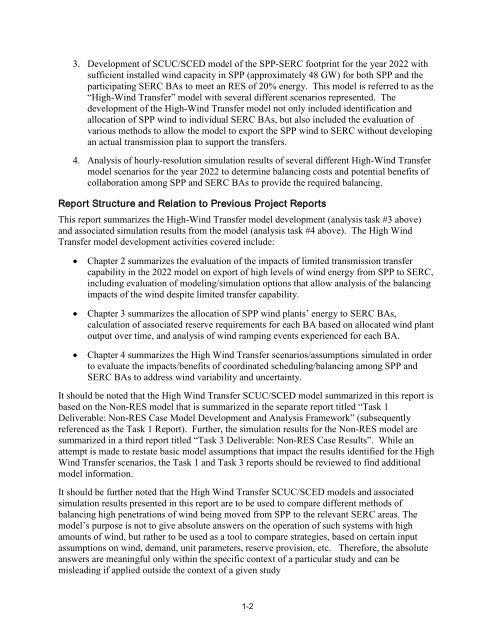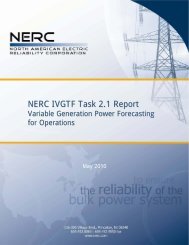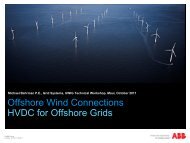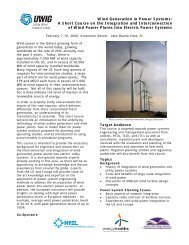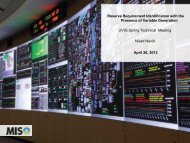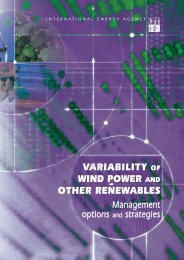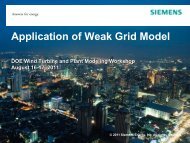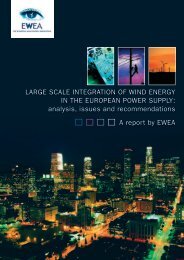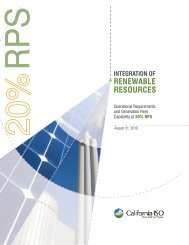Integrating Southwest Power Pool Wind to Southeast Electricity ...
Integrating Southwest Power Pool Wind to Southeast Electricity ...
Integrating Southwest Power Pool Wind to Southeast Electricity ...
Create successful ePaper yourself
Turn your PDF publications into a flip-book with our unique Google optimized e-Paper software.
3. Development of SCUC/SCED model of the SPP-SERC footprint for the year 2022 with<br />
sufficient installed wind capacity in SPP (approximately 48 GW) for both SPP and the<br />
participating SERC BAs <strong>to</strong> meet an RES of 20% energy. This model is referred <strong>to</strong> as the<br />
“High-<strong>Wind</strong> Transfer” model with several different scenarios represented. The<br />
development of the High-<strong>Wind</strong> Transfer model not only included identification and<br />
allocation of SPP wind <strong>to</strong> individual SERC BAs, but also included the evaluation of<br />
various methods <strong>to</strong> allow the model <strong>to</strong> export the SPP wind <strong>to</strong> SERC without developing<br />
an actual transmission plan <strong>to</strong> support the transfers.<br />
4. Analysis of hourly-resolution simulation results of several different High-<strong>Wind</strong> Transfer<br />
model scenarios for the year 2022 <strong>to</strong> determine balancing costs and potential benefits of<br />
collaboration among SPP and SERC BAs <strong>to</strong> provide the required balancing.<br />
Report Structure and Relation <strong>to</strong> Previous Project Reports<br />
This report summarizes the High-<strong>Wind</strong> Transfer model development (analysis task #3 above)<br />
and associated simulation results from the model (analysis task #4 above). The High <strong>Wind</strong><br />
Transfer model development activities covered include:<br />
• Chapter 2 summarizes the evaluation of the impacts of limited transmission transfer<br />
capability in the 2022 model on export of high levels of wind energy from SPP <strong>to</strong> SERC,<br />
including evaluation of modeling/simulation options that allow analysis of the balancing<br />
impacts of the wind despite limited transfer capability.<br />
• Chapter 3 summarizes the allocation of SPP wind plants’ energy <strong>to</strong> SERC BAs,<br />
calculation of associated reserve requirements for each BA based on allocated wind plant<br />
output over time, and analysis of wind ramping events experienced for each BA.<br />
• Chapter 4 summarizes the High <strong>Wind</strong> Transfer scenarios/assumptions simulated in order<br />
<strong>to</strong> evaluate the impacts/benefits of coordinated scheduling/balancing among SPP and<br />
SERC BAs <strong>to</strong> address wind variability and uncertainty.<br />
It should be noted that the High <strong>Wind</strong> Transfer SCUC/SCED model summarized in this report is<br />
based on the Non-RES model that is summarized in the separate report titled “Task 1<br />
Deliverable: Non-RES Case Model Development and Analysis Framework” (subsequently<br />
referenced as the Task 1 Report). Further, the simulation results for the Non-RES model are<br />
summarized in a third report titled “Task 3 Deliverable: Non-RES Case Results”. While an<br />
attempt is made <strong>to</strong> restate basic model assumptions that impact the results identified for the High<br />
<strong>Wind</strong> Transfer scenarios, the Task 1 and Task 3 reports should be reviewed <strong>to</strong> find additional<br />
model information.<br />
It should be further noted that the High <strong>Wind</strong> Transfer SCUC/SCED models and associated<br />
simulation results presented in this report are <strong>to</strong> be used <strong>to</strong> compare different methods of<br />
balancing high penetrations of wind being moved from SPP <strong>to</strong> the relevant SERC areas. The<br />
model’s purpose is not <strong>to</strong> give absolute answers on the operation of such systems with high<br />
amounts of wind, but rather <strong>to</strong> be used as a <strong>to</strong>ol <strong>to</strong> compare strategies, based on certain input<br />
assumptions on wind, demand, unit parameters, reserve provision, etc. Therefore, the absolute<br />
answers are meaningful only within the specific context of a particular study and can be<br />
misleading if applied outside the context of a given study<br />
1-2


